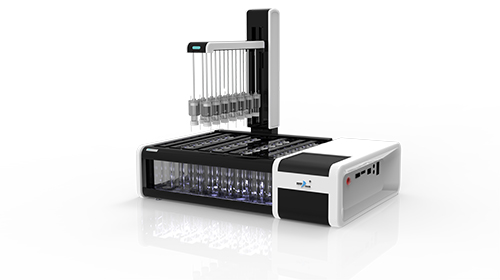What is a Reciprocating Cylinder Dissolution Tester?
I. Brief Introduction
The reciprocating cylinder dissolution apparatus (RCD) is an important device for drug dissolution testing. It utilizes a reciprocating cylinder and a precise temperature control system to simulate the drug dissolution process in the human gastrointestinal tract. During testing, tablets or capsules are placed in the cylinder, a specific solution is added, and stirring is performed at a constant temperature. The time-dependent changes in drug dissolution are recorded.
This instrument is widely used in various fields, including drug development and quality control, to assess drug dissolution rates and release behaviors, providing strong support for the development of clinical use strategies and improvements in manufacturing processes.
In addition, the RCD method offers a variety of adjustable parameters, such as medium pH, stirring rate, and ionic strength, as well as flexible draining time and reciprocating motion settings. Surfactants and inert beads can also be added as needed to meet the dissolution testing requirements of various drug formulations, such as sustained-release formulations, capsules, and pellets.
In practical applications, the RCD method has demonstrated significant advantages. For example, compared with basket and paddle methods, the reciprocating cylinder method demonstrated higher discrimination when measuring the dissolution profiles of HPMC matrix sustained-release tablets containing sulfonamides. By using plastic beads to simulate in vivo mechanical forces, the reciprocating cylinder method can more accurately reflect the in vivo dissolution performance of the drug and establish in vitro-in vivo correlation (IVIVC). Furthermore, for in vitro dissolution testing of chewable tablets, the vigorous stirring and addition of glass beads in the reciprocating cylinder method effectively simulate the chewing process, disintegrating the chewable tablet and promoting the dispersion and dissolution of the API.
The reciprocating cylinder method automated sampling dissolution system, consisting of a reciprocating cylinder dissolution apparatus and an automated sampling workstation, meets the requirements of the United States Pharmacopoeia, Chinese Pharmacopoeia, and European Pharmacopoeia. The apparatus utilizes a transparent hollow cylinder with screens installed at both ends. The sample to be tested is placed in the cylinder, which is then secured with screens at both ends. The cylinder is then gently reciprocated in a dissolution vessel containing dissolution medium. The dissolution medium flows through the screens and into the reciprocating cylinder, providing shear forces at the liquid-solid interface during drug dissolution. It is suitable for the dissolution study of new pharmaceutical preparations such as sustained-release preparations, positioned-release preparations, and enteric-coated delayed-release preparations.
II. Product Features
This product offers a range of advanced and practical features. First, it offers exceptionally flexible operating parameter settings. Users can freely set the reciprocating speed from 4 to 60 DPM, while the reciprocating stroke can be adjusted from 2 cm to 10 cm to suit experimental requirements. Furthermore, key parameters such as immersion time and drain time can be precisely configured to meet diverse experimental conditions. Second, the product features an intelligent transfer function that automatically and precisely transfers the reciprocating cylinder to the next row of dissolution vessels at pre-set intervals, significantly enhancing experimental automation and efficiency. Furthermore, the automatic dissolution vessel lid is a thoughtful design that opens and closes automatically, effectively preventing evaporation loss caused by prolonged exposure of the dissolution medium and ensuring the accuracy of experimental data.
For organizing and storing experimental components, the product comes with a reciprocating cylinder drying rack. After the experiment, users simply clean the reciprocating cylinder components and place them on a drying rack for quick access for the next experiment, ensuring they stay dry and clean while saving time. The automatic positioning of the sampling needle is also a highlight of this product. It automatically and precisely positions the needle midway between the bottom of the cup and the liquid surface, based on the volume of dissolution medium specified in the method, ensuring accurate and representative sampling.
In terms of user-interface functionality, the product features a 10-inch touchscreen pre-installed with the Retopo Dissolution Operating System. This system meets data integrity requirements and offers a simple, intuitive, and user-friendly interface, providing a convenient and efficient user experience. The integrated water bath is also uniquely designed, featuring rounded corners that eliminate blind spots and allow for thorough draining, ensuring a hygienic and stable experimental environment.
In addition, the product offers a wealth of expandable features. Users can choose to configure an automatic sampling workstation for fully automated sampling and refilling, further enhancing the automation level of the experiment. Even without an automated sampling workstation, users can still manually sample via the sampling port on the dissolution instrument mainframe, meeting experimental needs in various scenarios. The reciprocating cylinder utilizes a coaxial, split design, allowing users to quickly replace it with another reciprocating support component, greatly enhancing the product's versatility and flexibility. Finally, the sampling needle features automatic lifting and positioning at the sampling height, further improving sampling accuracy and experimental reliability.
Ⅲ. Working Principle
The working principle of the reciprocating cylinder dissolution apparatus involves a series of closely linked and scientifically rigorous key steps. First, sample placement requires the researcher to carefully and accurately place the glass reciprocating cylinder containing the sample to be tested into the dissolution vessel, which has been pre-filled with the specified dissolution medium. This step lays the foundation for the subsequent dissolution experiment. The selection and amount of dissolution medium must strictly adhere to experimental requirements to ensure the accuracy and reliability of the experimental results.
Next, the dissolution medium flows through the reciprocating cylinder through a carefully designed screen. The screen plays a key role here, evenly distributing the dissolution medium, ensuring a stable and appropriate flow rate through the reciprocating cylinder, thereby providing the appropriate shear force at the liquid-solid interface. This shear force is crucial for simulating the dissolution conditions of drugs in real physiological environments, more realistically reflecting the physical environment encountered by drugs in the body.
The reciprocating cylinder then begins its reciprocating motion, dipping in and out of the dissolution vessel. This rhythmic reciprocating motion is not a random design; rather, it's the result of extensive research and experimental validation, designed to closely simulate the complex dissolution and release behavior of drugs within the gastrointestinal tract. The gastrointestinal environment is complex and dynamic, including varying pH levels, the effects of digestive enzymes, and peristaltic motility. The reciprocating motion of the reciprocating cylinder simulates, to a certain extent, the effects of peristalsis on drug dissolution, making the experimental results more realistic than the actual in vivo drug experience.
Data recording is performed simultaneously throughout the experiment. High-precision testing equipment and an advanced data acquisition system provide a detailed time-varying curve of drug dissolution. This curve contains a wealth of information, visually demonstrating drug dissolution at different time points. By analyzing the curve, researchers can accurately assess the drug's dissolution rate and release behavior. The dissolution rate reflects the rate at which the drug enters the dissolution medium from the formulation, while the release behavior reflects the overall dissolution characteristics of the drug over time. These data are crucial for drug quality control and efficacy evaluation.
The reciprocating cylinder dissolution apparatus, through such a series of carefully designed working steps, with its scientific and reasonable design and precise and reliable working principle, can effectively simulate the dissolution process of drugs in the body, providing indispensable and important support for dosage form design, process optimization and quality control in the drug research and development process, and playing a key role in ensuring drug quality and efficacy.
Ⅳ. Operational Procedure
1. Precondition the equipment. Clean the equipment, check that it is operating properly, and verify that the instrument parameters meet the standards.
2. Install the reagents. Place the solute to be tested into the reciprocating cylinder and mix thoroughly. Then place the reciprocating cylinder into the sample chamber of the dissolution apparatus.
3. Start the experiment. Set parameters such as solution temperature and stirring intensity, and press the start button to begin the dissolution process.
4. Monitor the dissolution process. Monitor the dissolution volume and record the sample number, sampling time, and operator. Regularly maintain and adjust the dissolution apparatus's maintenance and quality control parameters.
5. End the experiment. After the experiment, clean and disinfect the sample and dissolution apparatus, and record the experimental results and data.
Ⅴ. Equipment Maintenance
To ensure the long-term stable operation of a reciprocating cylinder dissolution apparatus, regular maintenance is essential. Specific measures include:
Regularly check the accuracy of sensors and instrument parameters.
Regularly clean and sterilize the equipment, maintain normal operating temperature and humidity, and maintain the equipment's software and hardware systems to ensure system stability and data security.
With its scientific operating principles, rich and practical features, clear and standardized operating procedures, and comprehensive and meticulous equipment maintenance, the reciprocating cylinder dissolution apparatus has demonstrated outstanding performance and significant value in drug development and quality control. It not only provides researchers with accurate and reliable experimental data, assisting in dosage form design and process optimization, but also lays a solid foundation for ensuring drug quality and efficacy. With the continuous advancement of drug development technology, we believe that the reciprocating cylinder dissolution apparatus will continue to play a key role in driving the pharmaceutical industry towards higher quality and greater efficiency.


